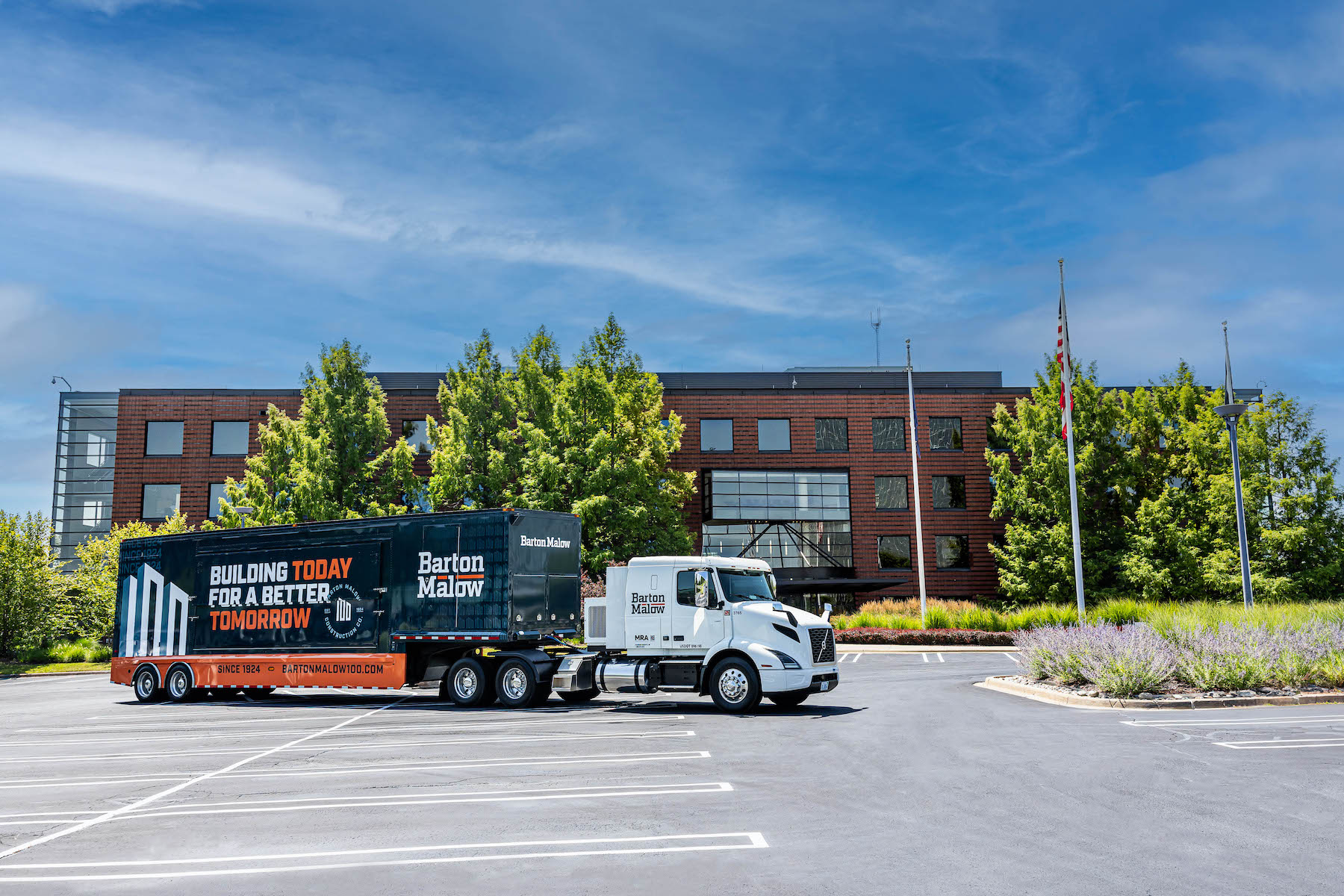The general contractor Barton Malow is taking its centennial celebration on the road.
This Friday, the company will make the first stop on its “Legacy Tour” in Detroit, a city where Barton Malow was founded by Carl Osborn Barton in 1924, and with which it has a long building history. (Its first contract was interior renovations for Michigan Bell Telephone Company.)
The company’s 100th anniversary exhibit, which includes special artifacts and interactive displays, is contained within a 42-ft truck, on the side of which reads Barton Malow’s tagline: “Building Today for a Better Tomorrow.”
(It takes about an hour to set up the stage and stairs to access the exhibit, says a company spokesman.)
Through the end of October, the truck is scheduled to make about 30 stops that will include 20 at Barton Malow projects and jobsites.
Celebrating employees and the Motor City
Ryan Maibach, the company’s fourth generation President and CEO, said in a prepared statement that Barton Malow’s anniversary is meant “to celebrate the contributions of the team members on our jobsites.” The Legacy Tour, he added, will “give team members the opportunity to experience this initiative.”
Barton Malow re-emphasizes its connection with Detroit on its website, which features a nearly 10-minute video where Maibach and three other team members—Kara Martini, Detroit office manager; Kevin Zeleji, Senior Director of Field Services; and Dannis Mitchell, Senior Director-Community Engagement—single out Detroit-area projects that Barton Malow built, including the historic restoration and rebuilding of the 130-room Shinola Hotel, which took two years to complete; and the construction of Little Caesars Arena, on which Barton Malow worked with Hunt and White Construction. Three-fifths of the contractors on the $862 million arena project were Detroit-based, said Mitchell.
“With every project we do, we’re partnering with the community,” said Zeleji on the video interview. Maibach, who has been the company’s president since 2011, also emphasized the importance of market diversity and expansion. Barton Malow launched its Mid-Atlantic operations in 1989, and is now building in 16 states nationwide and the Canadian province of Ontario. It serves nine building types.
Related Stories
Sustainability | Jun 24, 2024
CBRE to use Climate X platform to help clients calculate climate-related risks
CBRE will use risk analysis platform Climate X to provide climate risk data to commercial renters and property owners. The agreement will help clients calculate climate-related risks and return on investments for retrofits or acquisitions that can boost resiliency.
MFPRO+ News | Jun 24, 2024
‘Yes in God’s Backyard’ movement could create more affordable housing
The so-called “Yes in God’s Backyard” (YIGBY) movement, where houses of worship convert their properties to housing, could help alleviate the serious housing crisis affecting many communities around the country.
Student Housing | Jun 20, 2024
How student housing developments are evolving to meet new expectations
The days of uninspired dorm rooms with little more than a bed and a communal bathroom down the hall are long gone. Students increasingly seek inclusive design, communities to enhance learning and living, and a focus on wellness that encompasses everything from meditation spaces to mental health resources.
Museums | Jun 20, 2024
Connecticut’s Bruce Museum more than doubles its size with a 42,000-sf, three-floor addition
In Greenwich, Conn., the Bruce Museum, a multidisciplinary institution highlighting art, science, and history, has undergone a campus revitalization and expansion that more than doubles the museum’s size. Designed by EskewDumezRipple and built by Turner Construction, the project includes a 42,000-sf, three-floor addition as well as a comprehensive renovation of the 32,500-sf museum, which was originally built as a private home in the mid-19th century and expanded in the early 1990s.
Building Technology | Jun 18, 2024
Could ‘smart’ building facades heat and cool buildings?
A promising research project looks at the possibilities for thermoelectric systems to thermally condition buildings, writes Mahsa Farid Mohajer, Sustainable Building Analyst with Stantec.
University Buildings | Jun 18, 2024
UC Riverside’s new School of Medicine building supports team-based learning, showcases passive design strategies
The University of California, Riverside, School of Medicine has opened the 94,576-sf, five-floor Education Building II (EDII). Created by the design-build team of CO Architects and Hensel Phelps, the medical school’s new home supports team-based student learning, offers social spaces, and provides departmental offices for faculty and staff.
Mass Timber | Jun 17, 2024
British Columbia hospital features mass timber community hall
The Cowichan District Hospital Replacement Project in Duncan, British Columbia, features an expansive community hall featuring mass timber construction. The hall, designed to promote social interaction and connection to give patients, families, and staff a warm and welcoming environment, connects a Diagnostic and Treatment (“D&T”) Block and Inpatient Tower.
Codes | Jun 17, 2024
To avoid lawsuits, contractors and designers need to do more than comply with codes
Climate change is making design and construction more challenging and increasing the potential for lawsuits against building teams, according to insurance experts. Building to code is not enough to reduce liability because codes have not kept up with the rapid climate changes that are making extreme weather more common.
Concrete Technology | Jun 17, 2024
MIT researchers are working on a way to use concrete as an electric battery
Researchers at MIT have developed a concrete mixture that can store electrical energy. The researchers say the mixture of water, cement, and carbon black could be used for building foundations and street paving.
Codes and Standards | Jun 17, 2024
Federal government releases national definition of a zero emissions building
The U.S. Department of Energy has released a new national definition of a zero emissions building. The definition is intended to provide industry guidance to support new and existing commercial and residential buildings to move towards zero emissions across the entire building sector, DOE says.

















